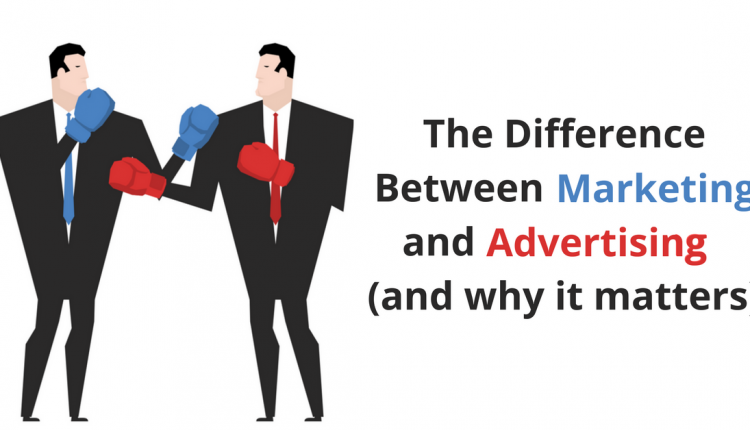Marketing and advertising are distinct majors in college. Most agencies are advertising agencies, and most departments inside companies that promote the sale of product are marketing departments.
Why the distinction? Are these two words synonyms, or is there a real difference?
A high-level, ephemeral topic like this isn’t something marketers spend most of their time thinking about. They’re too heads down, focused on budgets and marketing automation and copywriting. I know I am.
But I recently started taking MMC 5435: Messaging Strategy and the Centrality of the Value Proposition, part of the Communicating Value and Web Conversion graduate certificate created by MECLABS Institute (parent research organization of MarketingExperiments) in partnership with the University of Florida.
And so lately I’ve been pondering the bigger, more existential copies of marketing, such as this one. Marketing philosophy, if you will.
More than just nomenclature
To me, marketing is strategy and advertising is (but one) execution of that strategy. Marketing is the strategy of educating customers about a company’s choices in the marketplace, who their product or service will be a good fit for, and who it won’t. Advertising is then used to take that strategy and communicate it to an audience. This is part of the reason that many universities, UF included, place marketing programs in the College of Business and advertising in the College of Journalism and Communications.
So both advertising and marketing have the same goal. They both are, essentially, helping enable a choice. Usually in the company’s favor to enable reaching a conversion objective, but hopefully to enable the best decision for the customer — even if that best choice is not to purchase the company’s products.
But there is a key difference. Advertising is not holistic of the customer experience with a product. Even intelligent, multi-channel campaigns are impacting just a fraction of customer touchpoints with a brand.
And this is one of the biggest mistakes marketers make today. At least traditional marketers. They are too focused on getting in front of the customer with a conversion objective. But the real question should not be, “what is my objective as a marketer?”
The question marketers should ask to create a sustainably successful brand is, “what is my customer’s objective?” And “how can I help them meet it with every customer touch point?” That includes not only the actual product experience, but every experience with the customer, from customer service to return policy to, yes, advertising.
And this is why marketing should subsume advertising. Because the marketer is really the Chief Customer Experience Officer of the company. If it impacts the customer, it impacts the brand. And if it impacts the brand, it impacts purchase decisions.
How to improve marketing strategy (along with advertising)
Here are a few tips to help marketing directors and managers lead teams with a marketing-centric (not advertising-centric) approach to marketing strategy:
• Learn what the customer wants — Not just what they think about a specific product. Or competitor’s product. Or brand.
Why are they even considering products in a specific category? What dreams are they trying to achieve? What pain points are they trying to overcome?
This should be answered for each type of customer, and this helps a company discover its customer segments.
• Create a customer experience map — does your customer experience the brand? And competing brands? What ways can a company add touchpoints to create new experiences that help deliver what the customer wants?
Also, for most companies, there is likely more than one customer experience map. There is one for each customer segment.
• Serve the customer at each one of these touchpoints — This is a key way that marketing is so much bigger than just advertising. For example, you might discover that customers look to third-party websites and publications to do research before even considering your product. By engaging in content marketing, you could influence more customer decisions without buying any more ads.
Or you might discover that customers need to tangibly experience your product, but you sell it online. In that case, your marketing strategy might call for investing more budget in customer service and free return shipping and less budget on advertising. This is what Zappos did, and these tactics became the most effective marketing (by generating word of mouth and repeat customers) for the brand.
Serving customers is impossible if you don’t first learn what customers want, though. Take free shipping for example.
When we asked marketers how they improve the customers’ shopping experience through MarketingSherpa (MarketingExperiments’ sister publication), providing free shipping was tied for the ninth most popular option (18%).
However, when we asked consumers the same question, providing free shipping was by far the most popular response overall (74%).
This is just one example of the many disconnects between what customers value and what marketers value.
• Produce customer-focused advertising — What makes one ad better than another? Sure, there are a few basics of a good ad. It grabs the customer’s attention. It is placed in the right media so the ideal customer actually sees it.
But the most important quality of a good ad is that it uses a story to help the customer meet his or her objective. Some ads use creativity to do that. Others use facts and information. But they all directly tie customer desire to beneficial customer action in a quick and compelling way.
You might also like
Social Media Marketing: 9 tactics for B2B social channel advertising [From MarketingSherpa Case Study]
Inbound Marketing: 450% average ROI from Facebook advertising and organic content effort [From MarketingSherpa Case Study]



